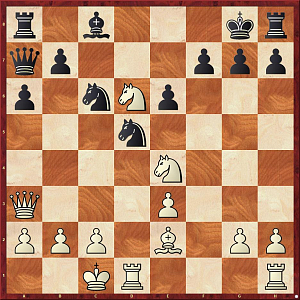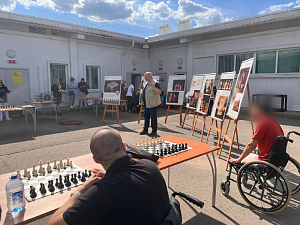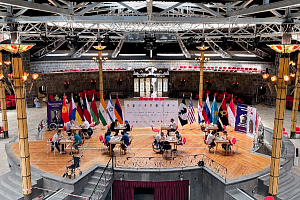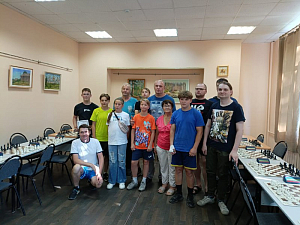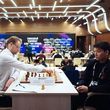Chessscapes from the Madrid Court
Review of Rounds 10-12 of the FIDE Candidates Tournament by GM Sergey Grigoriants
Round 10 again brought as many as three decisive games! Nakamura had plain sailing in punishing his younger opponent for experimental play in the opening. Ding and Rapport produced a very creative and meaningful game, in which luck eventually sided with the Chinese player. That said, Caruana seems in need of an urgent recharge of his batteries – the game against Duda made a very sad impression on everyone except the tournament lead Ian Nepomniachtchi, whose tournament position strengthened further following his uneventful draw against Radjabov.
Nakamura — Firouzja
Sicilian Defense
Round 10
1.e4 c5 2.Nf3 d6 3.d4 cxd4 4.Nxd4 Nf6 5.Nc3 a6 6.Be3 e5 7.Nf3
Nakamura opts for a calm continuation reputed for being quite harmless. Black indeed has many ways to get a very solid position here. The text is obviously not one of them.
7...Nc6 8.Bc4 Be6 9.Nd5 Rc8 10.Nxf6+ gxf6?!
.jpg)
It is audacious and self-confident, but in the long run can lead to weaknesses and problems rather than dynamic possibilities.
10...Qxf6 is more reliable.
11.Bb3 Ne7 12.0–0 Bxb3 13.axb3 d5 14.exd5 Qxd5 15.Qe2
Nakamura, of course, keeps queens and soon creates a textbook game that belongs to the theme of weak kings.
15...Nf5 16.Rfd1 Qc6 17.c4 Bg7 18.Rd5 0–0 19.Rad1 Rfe8 20.h3 b5 21.c5?!
The only moment where the engine disagrees and offers 21.Bc5! with a decisive positional advantage.
21...Bf8?
Black should not have allowed the creation of a protected passer. 21...a5! still maintained a quite playable position.
.jpg)
22.b4!
Provoking the opponent into taking the exchange, upon which the f5-knight turns out to be superior to the black rooks.
22...Nd4 23.Nxd4 Qxd5 24.Nf5 Qe4 25.Qh5 Red8 26.Ra1!
The rook stays in the game, and White's offensive is irresistible.
26...Rc6 27.Bh6 Kh8 28.Ra3 Qxb4 29.Bxf8 Rxf8 30.Qh6 Rg8 31.Rg3 Rxg3 32.fxg3 Black resigned.
There were games at this tournament, looking at which any strong candidate master could say: "I could play like that as well." As for strong grandmasters, they could generally come up with even more ambitious claims... The above statement is not about the next game. It was actually a top-level game in which both opponents brilliantly maintained tension in a completely unorthodox position. It's difficult to explain what happened even with the help of the engine, it's better just to enjoy the chessscapes!
Rapport – Ding Liren
Ruy Lopez
Round 10
1.e4 e5 2.Nf3 Nc6 3.Bb5 a6 4.Ba4 Nf6 5.d3 b5 6.Bb3 Bc5 7.Bg5!?
Rapport is the first to provoke complications that the bishop's move to g5 is known to come along with in similar positions.
7...h6 8.Bh4 d6 9.c3 Ba7 10.0–0 Na5 11.Bc2 c5 12.Nbd2 g5!?
The gauntlet is taken up!
13.Bg3 Nh5 14.a3 Rb8 15.Kh1
.jpg)
15…Rb7!?
This is the first message that Black is up to some creative achievements in this game. Instead of the commonplace and quite solid 15...0-0 there follows an unusual rook maneuver.
16.b4 Nc6 17.Bb3 Rc7 18.Bd5!?
White also spices the game up instead of simplifying it with 18.bxc5 Bxc5 19.a4.
18...g4!?
And Black takes up the gauntlet immediately! The engine votes for a calmer 18...cxb4 19.axb4 0–0. In general, almost every move points out to how the opponents refuse from simpler continuations in favor of complicating the game on purpose.
19.Bh4!?
The alternative is 19.Nh4.
19...Ne7 20.Ng1 cxb4
There follows a somewhat risky grab of a pawn, along the lines of the preceding play in general, instead of a more restrained 20...Qd7.
21.axb4 Rxc3 22.Ne2 Rc7
.jpg)
23.f4!
The position is quite in the style of Rapport and objectively looks more dangerous for Black, who will need to deal with the king issues.
23...f6!
It is already hard to say whether the 23...0–0 24.f5 Be3! with dynamic equilibrium was an easier alternative.
24.fxe5 dxe5 25.Ng3! Nxg3+ 26.hxg3 Rf8 27.Rxf6
The engine is not particularly happy with this human decision and offers 27.Rc1!? with an unpleasant initiative for the missing pawn.
27...Rxf6 28.Bxf6 Qd6 29.Qf1 Bd4 30.Bf7+!
It is noteworthy, however, how the engine changes the evaluation upon a closer look, again displaying zeros on the evaluation bar!
30...Kd7 31.Rd1 Rc2
The opponents have jointly created a position that is hard to understand and evaluate. Both sides have trump cards of their own, roughly balancing each other out.
32.Bb3 Rc7
.jpg)
33.Nc4!?
White is adding fuel to the fire in a very spectacular manner! It is not entirely risk-free, of course. There is no telling whether Ding was ready to finish the game by a repetition or whether he was just probing. Black had other continuations after 33.Bf7, such as 33...Qxb4!? 34.Bh4! Rc2 35.Qf6 with the same engine-given equality and entirely unpredictable struggle to come.
33...bxc4 34.dxc4
It's easy to get lost in such positions and derail in a few moves in some weird way. However, this is not about this position.
34...Rc6! 35.Ba4 Kc7 36.Bxc6 Nxc6 37.b5 Nb4
37...axb5!? 38.cxb5 Na5 is worth noting.
38.c5! Qe6! 39.Bh4! Bxc5 40.Rc1 Qd6! 41.Qc4 Nd3
.jpg)
The turning point of the most challenging duel! There are no real chances to score, and White forces the endgame transition. The opposite-colored bishops ending does look (even for the engine!) absolutely drawn at first glance...
42.Rc3
Instead of a human (too human) move, it was necessary to go for a strange-looking sacrifice 42.Be7! Qxe7 43.Qxd3 Kb6 44.bxa6 Bxa6 and realize that White had essentially nothing to fear due to black king's exposed position.
42...axb5 43.Qxd3 Qxd3 44.Rxd3 Bd4 45.Bf6
Refusal from the opposite-colored bishops via 45.Rd1 Kb6, was obviously a saver no longer.
.jpg)
45...Kb6! 46.Rxd4 exd4 47.Bxd4+ Ka5
This outflanking maneuver proves decisive for Black!
48.Kg1 b4 49.Kf2 Ka4 50.Ke3 Kb3 51.Kf4 Kc2 52.Ke5 b3 53.Kd6 Kd3! 54.Ba1 Kxe4 55.Kc5 Kd3 White resigned. Thus, going into round eleven, the Chinese and two American players were one and a half points behind the leader.
Many expected that in round eleven Firouzja would do his best to bounce back from his uninspired tournament performance by imposing a fight on the leader. They say that the night before he had even played as many as 250 bullet games to blow off some steam. The steam blowing was a success – shortly after the game started Alireza rushed to attack with g4, h4 and g5, upon which his position was already resignable.
Nakamura somehow played a surprisingly sluggish white opening against Rapport and never got any real winning chances. Ding spent most of the game against Caruana in a fighting-back mode, in which saving the game was the limit of Black's dreams, but at the end there happened an amazing turn of the tables – a dramatic game for the American chess player.
Firouzja – Nepomniachtchi
Petrov’s Defence
Round 11
1.e4 e5 2.Nf3 Nf6 3.Nxe5 d6 4.Nf3 Nxe4 5.c4 Nc6 6.d3 Nf6 7.d4 Be7!
White opted for a relatively rare line. Following the most natural 7...d5 8.c5!? there could have ensued a viscous strategic battle on the queenside. Ian's move is probably more precise and, in addition, led to the type of position much more compatible with his style.
8.d5 Ne5 9.Nd4 0–0 10.Nc3 Bg4
.jpg)
When commenting on the game online, Kramnik voiced skepticism about this attack, predicting White's advantage as its outcome. The engine is less emotional and believes that nothing special has happened so far, and that positional evaluation is not outside of equality. In the hindsight, knowing that the game would essentially go on for about ten moves only, one can already rate Ian's decision as an extremely on-spot one.
11.f3
Firouzja blitzed out his moves, demonstrating complete awareness of this position's inner workings. It soon became clear, however, that this speed was rather a continuation of the all-night bullet marathon.
Worthy of attention was 11.Be2!?
11...Bd7 12.Be2 c6 13.0–0 cxd5 14.cxd5 Qb6 15.Kh1 Rac8
The natural developing moves have been made, and it's time for White to present some sort of a plan. Having burned much clock, he choose the worst possible one.
.jpg)
16.g4?!
16.a4!? or 16.f4!? Nc4 17.b3 Ne3 18.Bxe3 Rxc3 19.Bg1 looked interesting and afforded a certain amount of pressure, for example: 19...Qa5 20.Bc4!? b5 21.Bd3 Nxd5 (21...Bd8!?) 22.Bf5.
16...h6 17.h4?
White could try to justify his previous move by 17.Nf5!? However, Black is not obliged to take the knight and has 17...Bd8!? instead.
17...Rfe8 18.g5
A very consistent and effective method when it comes to bullet chess. The engine, however, is deeply dissatisfied and believes that Black enjoys a huge advantage in more than one way, 18...Ng6!? among them.
18...hxg5 19.hxg5 Nh5 20.Kg2 Ng6 21.f4
White wins a piece, but his position is falling apart at the seams.
.jpg)
21...Nhxf4+! 22.Bxf4 Qxb2 23.Ne4 Rc4!?
Also strong was 23...Bd8!? 24.Nxd6 Rxe2+ 25.Nxe2 Rc2, with a decisive advantage. However, Ian is forcing transition into a technically winning endgame.
24.Be3 Bxg5! 25.Rb1 Qxa2 26.Ra1 Rxd4!
No repetitions, needless to say.
27.Rxa2 Rxd1 28.Bxd1 Bxe3 29.Nxd6 Re7 30.Bb3
It reminds of bullet chess again – the bishops is training his guns at f7 to strike at the opportune moment. As a result, the white king is left all alone in front of a powerful group of black pieces, and the game is over before long.
30.Re2 is tougher.
.jpg)
30...Bc5!
A tough rejoinder.
31.Nxb7
If 31.Nxf7, then 31…Re3.
31...Bb6 32.Bc4 Re3 33.Kh1 Bh3 34.Rc1 Bf5 35.Bf1 Be4+ White resigned.
Caruana – Ding Liren
Ruy Lopez
Round 11
An important asset for an athlete is the ability to distribute firepower over the tournament distance. Obviously, it is this component that is allegedly to blame for what has befallen Caruana.
1.e4 e5 2.Nf3 Nc6 3.Bb5 a6 4.Ba4 Nf6 5.0–0 Be7 6.Re1 b5 7.Bb3 0–0 8.a4 Bb7
The game has opened into one of the most up-to-date lines of Ruy Lopez.
9.d3 d6 10.Bd2 Qd7 11.Nc3 Na5 12.Ba2 b4 13.Ne2 c5 14.Ng3 Rab8 15.Nh4 g6 16.Bh6 Rfe8 17.Nhf5 Bd8 18.Ng7!?
.jpg)
This position looks out of this world, but the opponents reached it so quickly and confidently that both players produced the impression of being aware of the situation.
18...Rf8 19.h3 b3!
A typical idea.
20.Bxb3 Nxb3 21.cxb3 Bc6 22.Rc1 Kh8 23.Ne6
The knight gets out of the trap, and the balance of forces remains untipped.
23...Qxe6 24.Bxf8 Ba5 25.Bh6 Bxe1 26.Qxe1 Rxb3 27.Qa5 Ng8 28.Be3 Bb7 29.Qd2 f6 30.f4
.jpg)
This is the first turning point in this game. Both opponents were up to the task, and the position remains equal after any calm move. Instead, Ding is carried away with the fork idea.
30...exf4?!
Better is 30...Ne7!?
31.Bxf4 g5? 32.Be3 Qe5 33.Nf5! Ne7
Fortunately, Ding found out the drawback of his plan in due time. The planned 33...Rxb2 runs into the mighty tactical blow 34.Nxd6! Rxd2 35.Nf7+ Kg7 36.Nxe5 and a decisive edge for White because the black pawns are way too weak.
34.Nxe7 Qxe7 35.Qc2 Rb6
The resulting position is extremely unpleasant for Black, but the Chinese player fought like a lion and would not supply White with any opportunities to break through...
.jpg)
36.Rf1
Worthy of attention was the time-gaining pawn sacrifice: 36.b4!? Rxb4 37.Bd2 Rb6 38.Bc3.
36...Kg7 37.a5 Rc6 38.Bd2 Rc8! 39.Bc3 Rf8 40.Qf2 h6 41.h4 Bc8 42.b4 Bd7 43.bxc5 dxc5 44.Rb1
If we were to look for an improvement in White's play, it is somewhere around here. 44.hxg5 hxg5 45.Qf3!? was maintaining serious pressure, but it is far from obvious to a human player.
44...Bb5 45.hxg5 hxg5 46.Qf5 Kg8! 47.d4 Bd3 48.Re1 cxd4 49.Bxd4 Qh7 50.Qf3 Bb5 51.e5 Qd7!
Ding maneuvers precisely and keeps his head cool.
52.Bc5 Rc8 53.Qb3+ Qf7 54.e6
It looks formidable, but the pawn is easily blocked, and the chances of both sides are already equal.
54...Qc7 55.e7+ Kg7 56.Bd4 Qf4
Black's first active move proved surprisingly effective!
.jpg)
57.Be3?
A sense of danger abandons Fabiano, and he crosses the point of no return. The advantage has dissipated, and it was time to switch the reverse gear with – 57.Qe3!?
57...Qg3! 58.Qb4 Rh8 59.e8Q Qh2+ 60.Kf2 Rxe8 61.Qg4
A draw is forced by the engine-like 61.Bxg5! Rxe1 62.Qxe1 fxg5 63.Qe7+ Kg8 64.Qxg5+, and, following the trade of queens, Black finds himself in a position with the wrong bishop.
61...Qe5 62.Qd4 Qf5+ 63.Kg1 Kg6 64.Qd2 Bc6 65.Bf2 Qg4 66.Qd3+ Be4 67.Qg3 Qxg3 68.Bxg3
It is always hard to hold such endgames when pressed for time.
68...f5 69.Bc7 Kh5 70.Kf2 Kg4 71.Rc1 Re7 72.Rc3 Rd7 73.g3 Bd3 74.Bb8 Bb5 75.Bc7?
The final error in this dramatic battle!
.jpg)
75...Re7
The rook makes into the penultimate rank, and Black wins the game.
76.Bd8
Or 76.Rc2 Bd3.
76...Re2+ 77.Kg1 Rd2 78.Be7 Bd3 White resigned. Not without a fair share of luck, of course, but it is nonetheless the Chinese player's third victory in a row!
Round twelve is a farewell to the intrigue! At least in terms of contention for the first place. Everything is unclear about the second place following Carlsen's vague statements, and its significance in this Candidates Tournament may turn out to be much greater than usual. Probably, this is one of the reasons that Nakamura would not even try to put Ian to any kind of test. Firouzja was close to getting yet another zero, but Duda let him go. Caruana opted for the "Berlin" at last (now it's obvious that he should have done it back in round eight!) and didn't experience the slightest of problems in terms of equalizing.
Ding found himself burdened with the responsibility of keeping the tournament intrigue alive, but failed his mission. Obviously, as a result of three hard-fought victories, he ran out of firepower and crumbled miserably...
Ding Liren – Radjabov
Nimzo-Indian Defence
Round 12
1.d4 Nf6 2.c4 e6 3.Nc3
Nimzo-Indian Defence is a logical choice when it comes to playing for a win.
3...Bb4 4.e3 0–0 5.Bd3 d5 6.cxd5
A trendy variation that has recently found its way into the highest level.
6...exd5 7.a3 Bd6 8.Qc2 Na6!?
Teimour is the first to take his his opponent by surprise with a rare continuation, the impact of which proved deafening.
.jpg)
9.Nge2
Faced with the unexpected continuation, Ding reacted quite quickly. He was obviously out of firepower to solve strategic issues in a new for himself position.
Following this disaster game, the theoretician will look into the alternatives: 9.b4!?, 9.Nf3!?
9...c5!
This is the point: Black goes for a somewhat unorthodox position with isolated pawns, reasonably counting on a powerful pair of bishops.
10.Bxa6 bxa6 11.dxc5 Bxc5 12.b4
This pawn will provide a convenient hook for Black. Ding must have thought of 12.0–0 as too passive a continuation.
12...Bd6 13.Bb2 a5! 14.b5 a6 15.h3 Bd7
.jpg)
16.bxa6?!
There has been no trace of White's advantage for quite some time now, and the text makes the black pieces unpleasantly active for White.
Better is 16.a4!?
16...Rxa6 17.Rd1
A couple of days ago, the unusual rook maneuver (Rb7-c7) eventually found Ding on a lucky side against Rapport. This trick was clearly wide of the mark this time around!
17...Rb6 18.Rd2? Qc8
The white king is stuck in the center. Black's play is comfortable and effective.
19.f3
As if fighting with a motto "better a horrible end than horror without end"...
19...Re8 20.Kf2 Qb8 21.Qc1
.jpg)
21…Rxe3! 22.Nd1
22.Kxe3 Bc5+ 23.Nd4 Qe5+ loses the game.
22...Re8 23.Ne3 Rb3 24.Ng4 Bxg4 25.hxg4 Rc8 26.Qa1 Bf4 White resigned. This terrible failure once again goes to show that there is no such thing as nerves of steel.
As a result, with two rounds to go, the gap between the leader and his pursuers has increased to two points! Besides, the rest of the pack seems seriously concerned about the fight for the second place. Maybe the time has come for the world champion to deliver a more clear statement about his plans, at last?














